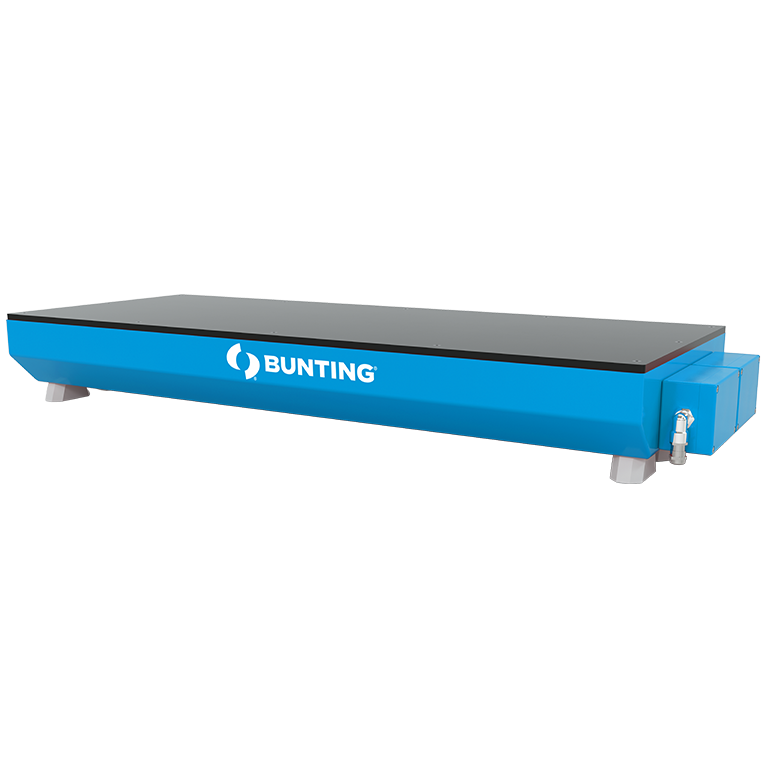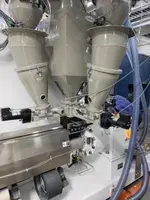Conveyor Metal Detector
| Materials: | Sand, gravel, coal, shredded plastics, biomass fuel, wood chips, cullet, raw silica, bulk raw materials |
| Detects: | Ferrous and non-ferrous |
| Applications |
Quarrying, mining, recycling, aggregate, mineral processing & bulk material handling |

Under-Belt Metal Detectors
Bunting Under-Belt Metal Detectors are engineered for continuous, non-intrusive detection of tramp metal beneath conveyor systems. They identify ferrous, non-ferrous, stainless steel, and manganese steel contaminants in bulk conveyed materials without disrupting product flow. Reliable in mining, recycling, biomass, wood, glass, and bulk material handling, these detectors protect shredders, crushers, chippers, and grinders from costly damage while reducing downtime and maintenance.
- About
- Benefits
- Applications
- How They Work
Under-Belt Metal Detectors protect downstream equipment by identifying tramp metal as material moves along the conveyor. Installed beneath the belt, they continuously scan conveyed product without interrupting flow.
These detectors are used in mining, recycling, biomass, wood processing, and glass manufacturing. They are capable of detecting contaminants such as stainless steel and manganese steel, preventing costly damage to crushers, grinders, and chippers.
With a compact, durable design, they perform reliably in demanding environments. Adjustable sensitivity and advanced electronics ensure effective detection across a wide range of burden depths and materials.
Reliable Tramp Metal Protection
Provides continuous under-belt monitoring to identify contaminants such as drill bits, bucket teeth, manganese liners, and fasteners before they damage critical equipment.
Comprehensive Metal Coverage
Detects ferrous, non-ferrous, stainless steel, and difficult-to-detect manganese steel contaminants across a wide range of bulk conveyed materials.
Non-Intrusive Installation
Mounts beneath non-metallic conveyor belts without disturbing product flow, making it ideal for high-throughput bulk handling.
Customizable Sensitivity Settings
Operators can fine-tune detection levels to match burden depth, product type, and processing requirements while reducing false trips.
Interfaces with Alarms & Control Systems
Connects to stop-on-detect controls, audible/visual alarms, and marker systems for fast response and effective tramp metal management.
Protects Downstream Equipment
Shredders, crushers, chippers, grinders, and other machinery are safeguarded from costly tramp metal damage and unplanned downtime.
Durable, Heavy-Duty Construction
Designed with minimal service needs, ensuring reliable protection in continuous 24/7 operations.
Under-Belt Metal Detectors are used to reduce downtime and equipment damage in:
-
Mining
-
Recycling
-
Biomass and wood processing
-
Glass manufacturing
-
Bulk material handling
They are effective on:
- Sand and gravel
- Coal
- Shredded plastics
- Biomass fuel
- Wood chips
- Cullet
- Raw silica
- Mineral ores
- Under Belt Detectors consist of a flat or triple-coil sensor mounted beneath the conveyor, and a control unit housed in an enclosure (commonly wall-mounted, local or remotely located).
-
When tramp metal is detected in the conveyed material, the coil sends a signal to the control unit, which processes it and triggers one or more control actions (stop belt, alarm, marker, or reject mechanism).
-
Designed for continuous inspection of bulk conveyed materials such as sand, gravel, coal, shredded plastics, biomass fuel, wood chips, cullet, raw silica, and mineral ores.
FAQ's
Under Belt Metal Detectors can detect ferrous metals, non-ferrous metals, stainless steel, and manganese steel. This includes common tramp metal contaminants such as drill bits, bucket teeth, fasteners, and crusher liners carried in bulk conveyed materials like coal, sand, gravel, biomass, and recycled plastics.
Under Belt Metal Detectors are installed beneath non-metallic conveyor belts or vibratory chutes. The design allows them to scan material on the belt without disrupting product flow or requiring modifications to the conveyor system, making them easy to integrate into new or existing bulk handling lines.
When tramp metal is detected, the sensor coil sends a signal to the control unit. The system processes the signal and automatically triggers a programmed response, which may include stopping the belt, activating an alarm, marking the location of the metal, or operating a reject mechanism. This ensures fast removal of metal and protection of downstream equipment.
Yes. Under Belt Metal Detectors feature fully adjustable sensitivity levels that can be tuned to the burden depth and material type. Product-effect compensation helps prevent false trips, ensuring accurate detection of ferrous, non-ferrous, and manganese steel contaminants even in challenging bulk applications.
Industries that rely on Under Belt Metal Detectors include mining, quarrying, recycling, biomass energy, wood processing, and glass manufacturing. They are also widely used in bulk material handling applications to protect crushers, grinders, shredders, and other heavy-duty processing equipment.
Under Belt Metal Detectors are designed for long service life with minimal maintenance. With no moving internal parts and rugged housings built for outdoor and dusty environments, they provide reliable protection while reducing maintenance costs.
Yes. Under Belt Metal Detectors are engineered with heavy-duty, weather-resistant housings and sealed electronics. They perform reliably in harsh, dusty, and high-throughput processing environments such as quarries, recycling plants, and biomass facilities.
Application Photos








Talk to an Application Engineer
Not sure what you need? Let’s talk through your application and identify the right solution.

